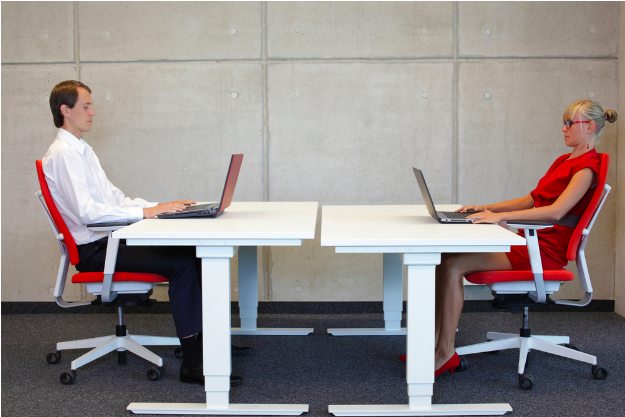Many office chairs out there like to be called ergonomic chairs, when in fact they are probably not much better than the bench at the park.
In this article, I’ll explore how to properly choose an ergonomic chair, so you can cut through all the marketing hype and find an office chair that actually reduces strain and improves your posture and comfort as you sit.
Table of Contents
The anatomy of an ergonomic chair
Here are some of the most important points to keep in mind when choosing an ergonomic office chair:
- Choose a chair where you can sit with your feet flat on the floor and your knees bent at a 90º angle.
- Your head and shoulders should be in line with your hips. To achieve this you want a chair that doesn’t allow you to slouch or slump forward.
- Your back needs to be supported by the chair’s backrest.
- Your buttocks should be at the back of the seat.
Sitting causes compression on the lower back discs, so sitting properly is more important than you may think. Ergonomic studies confirm over and over again that a comfortable, adjustable, supportive office chair increases productivity.
What to Look for In Detail
We look at what to look for when choosing one of these ‘performance enhancing’ chairs –
Adjustability and Comfort
An adjustable chair means you can use the levers and buttons available to adjust your chair to your unique levels of comfort. The best office chairs have at least 5 adjustable areas to the seat, armrests, and backrest
Certainly an important feature that needs to be adjustable is lumbar support and height. People want chairs with tilt adjustments so that they can go into a forward working posture or a reclined posture.
The Seat
The seat supports most of your weight, so you want a seat with adequate cushioning and which is wide enough to support your hips and thighs. The front part of the seat pan should have a gentle slope down feature to allow for a gap between the back of your knees and the front edge of the seat pan. This reduces pressure on the back of your thighs.
Back Support
The best ergonomic chair has an adjustable backrest that reclines at least 135 degrees. The backrest also needs to be lockable to guarantee solid back support. The backrest should be flexible – being able to move front- and backwards.
Armrests
Adjustable- or removable armrests are ideal for computer operators. People often wonder what the big deal is with armrests, but ultimately they are supporting the shoulders and preventing those aches and strains within the arm. Depending on the tasks of workers, wider or narrower arm rests may be required.
Weight Capacity
Choose an appropriate ‘weight capacity’ chair. For big and tall chair users, a chair needs to operate safely. Most chairs cater for up to 330 pounds but there are ‘big people’ chairs that cater for weights of 500 pounds. These chairs come with thick cushioning that won’t sag and deflate with constant use.
Swivel Base
You can hurt your neck and back badly without a swivel chair. A chair that swivels allows you to twist and turn freely in your chair to reach for things on your desk. Also, make sure to choose a 5-point base. Not only does this allow you to glide easily over different floor surfaces, it ensures the chair won’t tip.
Fabric
The fabric on the seat- and back of your chair needs to be breathable so you feel fresh and comfortable throughout the day. You don’t want to be sweating profusely on a hot day and feel as though you’re glued to your chair.
Some people like the looks of leather or vinyl, and while these materials are easy to clean, they don’t breathe like what fabric does and you’re inclined to sweat more with them.
Good Looks
Don’t underestimate a good-looking chair. Just loving the looks of your chair and knowing that it doubles as a ‘healthy’ chair is enough to release happy feelings or endorphins. Being in a positive, happy state has a significant impact on productivity, well-being, and motivation.
Summing Up
Sitting all day isn’t relaxing. It may feel like it, but quietly and consistently, negative things are happening within your body that may only manifest themselves years later.
Every office needs to seriously consider these chairs for their staff so as to optimize their worker’s productivity.
An ergonomic office chair encourages good posture, it eliminates physical discomfort, eliminates regular absenteeism and prevents serious future health problems.



